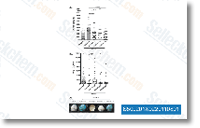Cytosolic modules inside the epithelial mesenchymal transition network correspond to distinct signaling cascades We partitioned the EMT network into nine modules and targeted our analyses to the four biggest and most densely linked modules.They have 86% from the two,543 genes during the EMT network, though the re maining 6 modules have been both tiny or dispersed through the entire network.An enrichment of cell surface receptors and membrane proteins exists inside 3 from the modules.We refer to this group since the upstream modules. According to this observation, we hypothesized that distinct network modules could have distinct molecular traits. To test this we even more characterized the modules by means of GO terms, molecular signatures, and pathways. We observed the 3 upstream modules correspond to 3 signaling cascades. TGFB, TNF NF kB, and receptor tyrosine kinases.
TGFB receptor signaling Module M1 most drastically associates together with the TGFB, and BMP signaling pathways, but can also be enriched for genes associated with advancement, cell proliferation, apop tosis, and differentiation. From GO, by far the most enriched biological processes are EMT and mesenchymal differentiation.Regarding pathways, we identified that this module is most considerably enriched for that TGFB selleck chemicals pathway and various molecular functions associated with TGFB signaling. By way of example, BMP signaling events and proteins known to bind activin A are strongly enriched. The two BMPs, and activin A belong for the TGFB superfamily. Canonically, TGFB utilizes receptor S. T kinases to activate the SMAD proteins. As expected, we observed overrepresentation of genes that regulate SMADs by means of phosphorylation and mediate their nuclear import in M1. These findings indicate that mod ule M1 captures the TGFB and BMP signaling pathways, which are essential to EMT induction.
TNF. NF kB signaling Module M4 consists of the TNF NF kB signaling network and is also enriched for genes from your MAPK signaling pathway. The vast majority of genes which can be annotated as me diators of apoptosis signaling reside within this module. Specif ically, M4 has all annotated genes in the extrinsic apoptosis pathway.and large enrichments for your intrinsic.standard.and caspase apoptosis pathways. Yet another defining Candesartan characteristic of M4 is TNF signaling, since all annotated genes on this pathway are in cluded.Persistently, this module includes genes involved with signaling pathways upstream of NF kB.Additionally, we observed enrichment in the IL1.Toll  like.and NOD like pathways. All of those receptors are activated by professional inflammatory signals, and converge on NF kB. We also mentioned an overrepresentation of cytosolic mediators of immune responses. Particularly, you will find enrichments for your IKK complicated.the TAK1. JNK cascade.as well as MAPK tension activated cascade.
like.and NOD like pathways. All of those receptors are activated by professional inflammatory signals, and converge on NF kB. We also mentioned an overrepresentation of cytosolic mediators of immune responses. Particularly, you will find enrichments for your IKK complicated.the TAK1. JNK cascade.as well as MAPK tension activated cascade.
Microrna Synthesis
MiRNAs are abundant in many mammalian cell types.
